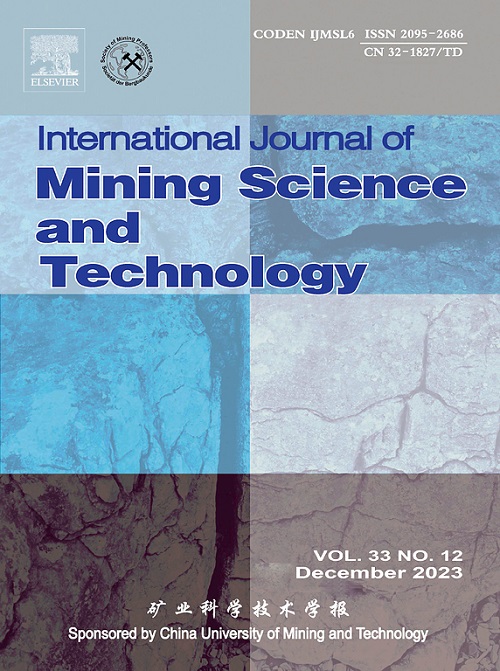对水平井进行多级水力压裂,以控制与硬顶板有关的煤层突水:从数值模拟到现场应用的启示
IF 11.7
1区 工程技术
Q1 MINING & MINERAL PROCESSING
International Journal of Mining Science and Technology
Pub Date : 2024-08-01
DOI:10.1016/j.ijmst.2024.08.008
引用次数: 0
摘要
在中国,水平井多级水力压裂(MFHW)是一项很有前景的技术,可用于控制厚硬顶板引起的煤层突水。然而,多级水平井水力压裂控制煤层突水的机理以及相关压裂效果的评估仍面临挑战。本研究根据中国某煤矿硬顶煤层超临界水力压裂实际运行参数,通过数值建模和现场应用对这些挑战进行了研究。提出了一个破坏参数(D)来评估顶板的水力压裂程度。利用微地震(MS)数据和前突应力分布分析了中频水力压裂控制煤层突水的机理和效果。结果表明,压裂程度可分为轻度压裂(D≤0.3)、中度压裂(0.3<D≤0.6)、良好压裂(0.6<D≤0.9)和过度压裂(0.9<D≤0.95)。压裂过程中的反应阶段以裂缝发展缓慢为特征,表明已过渡到良好压裂状态。MFHW之后,前承应力的区域范围和峰值都有所减小。此外,MS事件从煤层附近转移到断裂顶板层,MS事件数量增加,而平均MS能量下降。煤层突水的MFHW控制机制包括减轻开采引起的应力和减少长壁后退过程中的地震活动,确保应力保持在极限应力水平以下。这些发现为工程中评估 MFHW 压裂效应和控制煤爆灾害提供了参考。本文章由计算机程序翻译,如有差异,请以英文原文为准。
Multistage hydraulic fracturing of a horizontal well for hard roof related coal burst control: Insights from numerical modelling to field application
Multistage hydraulic fracturing of horizontal wells (MFHW) is a promising technology for controlling coal burst caused by thick and hard roofs in China. However, challenges remain regarding the MFHW control mechanism of coal burst and assessment of the associated fracturing effects. In this study, these challenges were investigated through numerical modelling and field applications, based on the actual operating parameters of MFHW for hard roofs in a Chinese coal mine. A damage parameter (D) is proposed to assess the degree of hydraulic fracturing in the roof. The mechanisms and effects of MFHW for controlling coal burst are analyzed using microseismic (MS) data and front-abutment stress distribution. Results show that the degree of fracturing can be categorized into lightly-fractured (D≤0.3), moderately fractured (0.3<D≤0.6), well-fractured (0.6<D≤0.9), and over-fractured (0.9<D≤0.95). A response stage in the fracturing process, characterized by a slowdown in crack development, indicates the transition to a well-fractured condition. After MFHW, the zone range and peak value of the front-abutment stress decrease. Additionally, MS events shift from near the coal seam to the fractured roof layers, with the number of MS events increases while the average MS energy decreases. The MFHW control mechanisms of coal bursts involve mitigating mining-induced stress and reducing seismic activity during longwall retreat, ensuring stresses remain below the ultimate stress level. These findings provide a reference for evaluating MFHW fracturing effects and controlling coal burst disasters in engineering.
求助全文
通过发布文献求助,成功后即可免费获取论文全文。
去求助
来源期刊

International Journal of Mining Science and Technology
Earth and Planetary Sciences-Geotechnical Engineering and Engineering Geology
CiteScore
19.10
自引率
11.90%
发文量
2541
审稿时长
44 days
期刊介绍:
The International Journal of Mining Science and Technology, founded in 1990 as the Journal of China University of Mining and Technology, is a monthly English-language journal. It publishes original research papers and high-quality reviews that explore the latest advancements in theories, methodologies, and applications within the realm of mining sciences and technologies. The journal serves as an international exchange forum for readers and authors worldwide involved in mining sciences and technologies. All papers undergo a peer-review process and meticulous editing by specialists and authorities, with the entire submission-to-publication process conducted electronically.
 求助内容:
求助内容: 应助结果提醒方式:
应助结果提醒方式:


